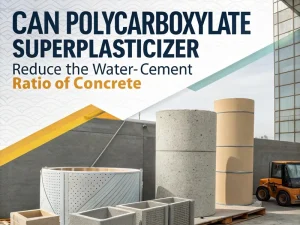Blog
Abstract: In architecture and engineering, we are continuously pursuing concrete that is stronger, more durable, and easier to construct. To achieve this goal, a core challenge is balancing the “water” in concrete. The key to solving this challenge lies in a chemical additive called a water reducer.
Water reducing agent is a concrete admixture that can reduce the amount of water used in mixing while maintaining the basic consistency of concrete slump. Most of them belong to anionic surfactants. When it is added to concrete, it can have a dispersing effect on cement, improve the workability of concrete, reduce the unit water consumption, and enhance the fluidity of concrete, or reduce the unit cement consumption to save cement.
The workability of concrete depends on the ease of sliding between its components (cement, aggregate, water). In a standard mixture, cement particles gather together due to electrostatic attraction, capturing moisture and making the mixture harder. Water reducing agents disrupt this process through two key mechanisms:
Water reducing agents are classified based on their water reducing efficiency and chemical composition. The three main types are:
Water reduction: 5-15%
Chemistry: usually derived from natural materials such as lignosulfonates (by-products of wood pulp processing) or hydroxylated carboxylic acids.
Purpose: Very suitable for general construction projects that require moderate workability, such as residential slabs, beams, and foundations. They improve the pumpability of concrete and reduce bleeding (water separation in the mixture).
Water reduction: 15-20%
Also known as superplasticizers, including naphthalene series, melamine series, amino sulfonate series, aliphatic series, etc.
Water reduction: 20-40%
Chemistry: Advanced synthetic compounds, most commonly polycarboxylate ethers (PCE), are highly effective in dispersing cement particles.
Purpose: It is crucial for high-performance concrete, such as skyscrapers, bridges, and self-compacting concrete (SCC). SCC flows freely and without vibration, making it an ideal choice for complex molds or dense steel bars. High-range water-reducing agents can also achieve ultra-high-strength concrete (over 10000 psi) by minimizing moisture content.
Enhance strength: The concrete becomes denser by lowering the water-cement ratio and using water-reducing agents. This will increase compressive strength by 10-30% (or even more when using high-range reducing agents), as less water means fewer pores and stronger bonding between cement particles.
Improve work performance: Even with less water, concrete maintains fluidity, making it easier to pour, pump, and complete. This is particularly valuable for large projects or areas that are difficult to reach, such as high-rise building columns or underground tunnels.
Enhanced durability: Dense concrete can resist water infiltration, chemical erosion (such as de-icing salts or industrial fluids), and freeze-thaw damage, extending the structure’s life.
Reduce cement usage: In certain mixtures, water-reducing agents allow builders to use less cement while maintaining strength, lowering costs, and reducing carbon footprint (cement production is a significant source of carbon dioxide).
Better surface treatment: reduces bleeding and segregation, making the concrete surface smoother and more uniform, making it an ideal choice for decorative elements or exposed concrete designs.
Dosage: usually 0.5-3% of the weight of cement. Overdosing can lead to excessive slump loss (loss of processability over time) or segregation, so please follow the manufacturer’s guidelines.
Mixing: It can be added during the concrete batching process, either in the mixer or after the addition. High-range reducing agents (such as PCE) are usually most effective when added after initial mixing to maximize dispersion.
Compatibility: Tested with local cement and aggregates; some water reducing agents may react poorly with certain materials such as fly ash or slag.
For example, in a bridge project that requires high-strength concrete, PCE based high-efficiency water reducing agents may reduce the moisture content by 30%, allowing the mixture to reach a strength of 8000 psi while maintaining sufficient fluidity to be poured around dense steel bars.
Water reducing agent in concrete is an essential admixture that solves the classic trade-off between strength and workability. Because of water reducing agents, we can build safer, more economical, and more durable buildings, bridges, and infrastructure, shaping the world we live in today.

Can Polycarboxylate Superplasticizer Reduce The Water Cement Ratio Of Concrete?
Blog Can polycarboxylate